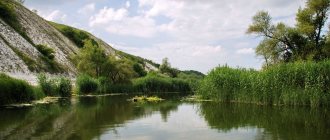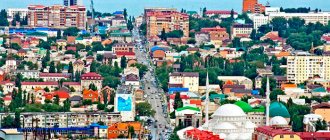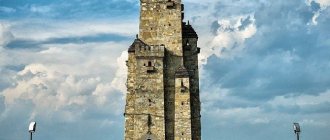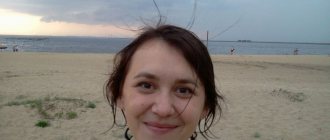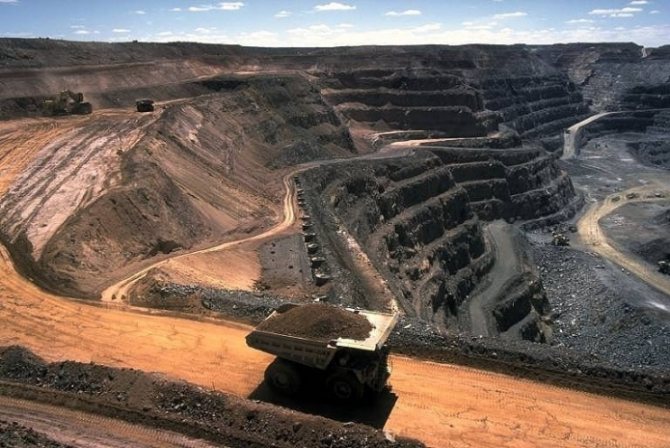Sights of the city of Furmanov - Furmanov - Ivanovo region - Catalog of articles
Church of the Ascension of the Lord The oldest (XVIII-XIX centuries) Furmanovskaya church.
People call the temple “White”, distinguishing it from the local Church of the Mother of God “Joy of All Who Sorrow”, which is made of red brick. The wooden Ascension Church was first mentioned in 1614. The brick church was erected in 1727 at the request of the owner of the village, General - Major Prince I. F. Baryatinsky - and radically rebuilt into the second floor. XIX century Furmanov Art Gallery named after D. A. Trubnikov
The museum presents historical, archaeological and local history exhibitions, and holds regular creative meetings. The museum building is a 19th-century residential building, which has largely preserved the layout and interior decoration: a three-story mansion with a basement and an underground passage. The decoration of the house is a stone hall and a veranda with access to an ancient park.
Memorial room-museum of the Ivanovo poet Mikhail Dudin in the village of Shirokovo The basis of the fund is materials about the life and work of the poet, literary collections of Mikhail Dudin. Among the valuable exhibits are books from the poet’s personal library. The majority of the fund consists of local history materials: paintings by artists V. Zhuravlev and Y. Pyatov with views of the surrounding area.
Museum of History and Local Lore at the Higher Professional Lyceum No. 7
Historical and local history materials tell about the past of Sereda, introduce the owners of the village, representatives of the boyar and princely families who owned the surrounding lands.
St. Michael's Church
According to legend, the first wooden church was built on this site by the monks of this particular monastery. The corresponding mention in 1565 in the hundredth of the Kostroma books, books of Prince Alexander Dimitrievich Danilov and Ondrei Vasiliev, son of Timofeevich Beznosov and his comrades: “Ipatsky Monastery ... Ipatsky Monastery in the Kostroma district in the Yeletsk volost, the village of Mikhailovskoye on the river on Shacha, given to Prince David Feodorovich Galitsky ..."
Memorial Museum of D.A. Furmanov
On October 26, 2005, after a long period of 10 years, the D.A. Furmanov Museum reopened its doors to residents and guests of the city of Furmanov. In the museum exhibition “Medium. A View from the 21st Century,” dedicated to the history of the city in the 19th – early 20th centuries, presents a panorama of the life of the region with its political and social upheavals. The exhibition is based on originals, a significant part of which: documents, paintings, household items, rare books, clothing. The picturesque row is represented by the works of the artist D.A. Trubnikova (1885-1947).
allsity.ucoz.net
Content
- 1 Geography
- 2 History
- 3 Population
- 4 Economics
- 5 Sights 5.1 Church of the Ascension of the Lord (parish of the Ascension Church)
- 5.2 Memorial Museum of Dmitry Furmanov
- 5.3 Furmanov Art Gallery named after D. A. Trubnikov
- 5.4 Museum of History and Local Lore at Secondary Vocational Lyceum No. 7
Furmanov – Mycicerone – travel and tourism in cities and countries
Material from Mycicerone - travel and tourism in cities and countries
[edit] A little about Furmanov
Furmanov is a regional center in the north of the Ivanovo region of Russia, located on the banks of the Shacha River, a right tributary of the Volga, 30 kilometers northeast of Ivanovo.
The city gave the world a commissar in the Chapaev Division and a writer Dmitry Andreevich Furmanov (1891-1926), whose name the city bears since March 13, 1941.
[edit] Furmanov districts
[edit] How to get to Furmanov
[edit] by plane
The nearest airport is in Ivanovo.
[edit] by train
The Nizhny Novgorod - Ivanovo - Yaroslavl railway passes through Furmanov. Trains from the Volga region to St. Petersburg and Yaroslavl stop here, including two daily Ivanovo↔Yaroslavl trains.
[edit] by bus
[edit] by car
Furmanov is located on the A113 highway Kostroma - Ivanovo.
[edit] on the ship
The river is not navigable.
[edit] Urban transport Furmanov
[edit] Hotels in Furmanovo
Address: Ivanovo region, Furmanov, Sovetskaya street, 12 Phone: +7(49341)2-15-71 Description:
[edit] Sights of Furmanov
- A secondary school building built in 1929-30 at 28 Revolutsionnaya Street.
- The former estate of the manufacturer Gorbunov at Sovetskaya Street, 6.
- The former estate of the merchant Losev at Sovetskaya Street, 9 and 10.
- Orthodox Church of the Intercession of the Blessed Virgin Mary on Sovetskaya Street, 14.
- Old Believer Chapel on Sovetskaya Street, 15.
- Monument to D.A. Furmanov by sculptor N.V. Dydykin on Socialist Street, erected in 1960.
- Orthodox Church of All Who Sorrow Joy at 36 Socialist Street, built at the end of the 19th century.
- Church of the Nativity of the Blessed Virgin Mary, built in the late 1990s on the territory of a spinning factory.
[edit] Museums in Furmanovo
Address: Ivanovo region, Furmanov, Bolshaya Furmanovskaya street, 69 Phone: +7(49341)2-09-00 Opening hours: 11:00-17:00, Thursday 14:30-21:00, except Mondays and last Friday every month Tickets: Description: In this house, according to legend, the writer and commissar Dmitry Furmanov was born.
- Furmanov Art Gallery named after D.A. Trubnikov
Address: Ivanovo region, Furmanov, Sovetskaya street, 6 Telephone: Opening hours: Tickets: Description:
- Museum of History and Local Lore at the Higher Professional Lyceum No. 7
Address: Ivanovo region, Furmanov, Timiryazeva street, 43 Phone: +7(49341)2-50-58 Opening hours: Tickets: Description:
[edit] Entertainment in Furmanovo
[edit] Food in Furmanovo
[edit] Information on the Internet about Furmanov
- furmanov.net - website of the district Administration
- furmanoff.ru - city website
www.mycicerone.ru
Notes
- ↑ 12
www.gks.ru/free_doc/doc_2016/bul_dr/mun_obr2016.rar Population of the Russian Federation by municipalities as of January 1, 2016 - Gorodetskaya I. L., Levashov E. A.
[books.google.com/books?id=Do8dAQAAMAAJ&dq=%D0%A4%D1%83%D1%80%D0%BC%D0%B0%D0%BD%D0 %BE%D0%B2 Furmanov] // Russian names of residents: Dictionary-reference book. - M.: AST, 2003. - P. 309. - 363 p. — 5000 copies. — ISBN 5-17-016914-0. - ↑ 12
THE USSR. Administrative-territorial division of the union republics on January 1, 1980 / Compiled by V. A. Dudarev, N. A. Evseeva. - M.: Publishing house "Izvestia of the Soviets of People's Deputies of the USSR", 1980. - 702 p. — P. 122. - ↑ 12345678910111213
www.MojGorod.ru/ivanovsk_obl/furmanov/index.html People's encyclopedia “My City”. Furmanov (city) - [demoscope.ru/weekly/ssp/rus59_reg2.php All-Union Population Census of 1959. The size of the urban population of the RSFSR, its territorial units, urban settlements and urban areas by gender] (Russian). Demoscope Weekly. Retrieved September 25, 2013. [www.webcitation.org/6GDOghWC9 Archived from the original on April 28, 2013].
- [demoscope.ru/weekly/ssp/rus70_reg2.php All-Union Population Census of 1970 The size of the urban population of the RSFSR, its territorial units, urban settlements and urban areas by gender.] (Russian). Demoscope Weekly. Retrieved September 25, 2013. [www.webcitation.org/6GDOiMstp Archived from the original on April 28, 2013].
- ↑ 123
[ivanovo.gks.ru/wps/wcm/connect/rosstat_ts/ivanovo/resources/4ce371004da3f783837cf741cd117b4b/itogi_vpn2010_table_volume_1.pdf Results of the 2010 All-Russian Population Census, volume 1. Number and distribution of the population of the Ivanovo region]. Retrieved August 8, 2014. [www.webcitation.org/6Rfo0NidC Archived from the original on August 8, 2014]. - [www.perepis2002.ru/ct/doc/1_TOM_01_04.xls All-Russian Population Census 2002. Volume. 1, table 4. Population of Russia, federal districts, constituent entities of the Russian Federation, districts, urban settlements, rural settlements - regional centers and rural settlements with a population of 3 thousand or more]. [www.webcitation.org/65AdCU0q3 Archived from the original on February 3, 2012].
- [www.gks.ru/bgd/regl/B09_109/IssWWW.exe/Stg/d01/tabl-21-09.xls Number of permanent population of the Russian Federation by cities, urban-type settlements and districts as of January 1, 2009]. Retrieved January 2, 2014. [www.webcitation.org/6MJmu0z1u Archived from the original on January 2, 2014].
- [www.gks.ru/free_doc/doc_2012/bul_dr/mun_obr2012.rar Population of the Russian Federation by municipalities. Table 35. Estimated resident population as of January 1, 2012]. Retrieved May 31, 2014. [www.webcitation.org/6PyOWbdMc Archived from the original on May 31, 2014].
- [www.gks.ru/free_doc/doc_2013/bul_dr/mun_obr2013.rar Population of the Russian Federation by municipalities as of January 1, 2013. - M.: Federal State Statistics Service Rosstat, 2013. - 528 p. (Table 33. Population of urban districts, municipal districts, urban and rural settlements, urban settlements, rural settlements)]. Retrieved November 16, 2013. [www.webcitation.org/6LAdCWSxH Archived from the original on November 16, 2013].
- [www.gks.ru/free_doc/doc_2014/bul_dr/mun_obr2014.rar Table 33. Population of the Russian Federation by municipalities as of January 1, 2014]. Retrieved August 2, 2014. [www.webcitation.org/6RWqP50QK Archived from the original on August 2, 2014].
- [www.gks.ru/free_doc/doc_2015/bul_dr/mun_obr2015.rar Population of the Russian Federation by municipalities as of January 1, 2015]. Retrieved August 6, 2015. [www.webcitation.org/6aaNzOlFO Archived from the original on August 6, 2015].
- taking into account the cities of Crimea
- [www.gks.ru/free_doc/doc_2016/bul_dr/mun_obr2016.rar Population of the Russian Federation by municipalities as of January 1, 2016. Table “31. Population of cities and towns by federal districts and constituent entities of the Russian Federation as of January 1, 2016.” RAR archive (1.0 MB)]
- Ministry of Culture of the Russian Federation
. [old.kulturnoe-nasledie.ru/monuments.php?id=3700001133 No. 3700001133] // Website “Objects of cultural heritage (historical and cultural monuments) of the peoples of the Russian Federation.” Verified - [sereda-upino.narod.ru/ Website of the parish of the Ascension Church]
- [www.museum.ru/M526 Memorial Museum of Dmitry Furmanov
] - [www.museum.ru/M526 Memorial Museum of D. A. Furmanov] Museums of Russia
- [www.museum.ru/M1848 Furmanov Art Gallery named after D. A. Trubnikov
] - [www.furmanov.net/index.php?option=com_content&task=view&id=21&Itemid=76 Museum of History and Local Lore at the Higher Professional Lyceum No. 7
] - ↑ 12
[tourizm.ivanovo.ru/M1-5-14 Golden Ring of Russia. Ivanovo region - Tourist center]
Furmanov (city) is... What is Furmanov (city)?
This term has other meanings, see Furmanov.
Losev's mansion (Gallery named after Trubnikov) Furmanov is a city (since 1918) in Russia, the administrative center of the Furmanovsky municipal district of the Ivanovo region.
Geography
The city is located on the non-navigable Shacha River (a tributary of the Volga), 33 km from Ivanovo, which is connected by a national highway (Route A113 Kostroma - Ivanovo), as well as by railway.
Story
Formed on the basis of the growth of factory workers' settlements. It received its original name from the largest village - Sereda-Upino (mentioned since 1628). In 1918 it received city status. In the period from 1918 to 1941 the city was called Sereda, on March 13, 1941 it was renamed in honor of the (presumably) Russian writer Dmitry Andreevich Furmanov, who was born here. Although it has already been proven that D. A. Furmanov was born in the village of Aleshino, Yaroslavl region. and in Sereda little Dmitry was only baptized. [source not specified 177 days]
Furmanovskoye urban settlement on the map of Furmanovsky district
In 2005, the city of Furmanov was given the status of an urban settlement within the Furmanovsky municipal district.
Now the city is developing according to the master plan developed by Baza LLC in 2009. The total length of 226 streets and roads is 120 km. The city area is 15.59 square meters. km, area 763.2 sq. km. Population - 37.5 thousand people (as of 01/01/2009).
Economy
The largest enterprises in the city are the Furmanovsky Foundry and Mechanical Plant (it went bankrupt and is currently in disrepair), the machine-building plant (since 2011 it has been completely bankrupt, the staff was fired), 3 spinning and weaving enterprises: Furmanovskaya Factory No. 1 LLC, JSC Furmanovskaya Spinning and Weaving Factory No. 2, Spinning and Weaving Factory No. 3 of the Shuya Calico Holding, sewing enterprises, a bakery, a dairy plant, forest industry enterprises. In 2010, self-produced goods were shipped, work and services were performed in-house for manufacturing activities at large and medium-sized enterprises - 1.33 billion rubles. The Limaton Upakovka enterprise, which produces various types of packaging material, is located in the former premises.
Attractions
Temple of the Mother of God “Joy of All Who Sorrow”
The city is included in the tourist route “Golden Ring of Russia”. Among the architectural monuments are the house in which D. A. Furmanov was born, the house where the artist D. A. Trubnikov lived and worked (lost in the 80s of the twentieth century), the estates of manufacturers Gorbunov and Losev, an art gallery, a temple of all Joy of the Sorrowful (1886-97).
Church of the Ascension of the Lord (parish of the Ascension Church)
The oldest (XVIII-XIX centuries) Furmanovskaya church. People call the temple “White”, distinguishing it from the local Church of the Mother of God “Joy of All Who Sorrow”, which is made of red brick. The wooden Ascension Church was first mentioned in 1614. The brick church was erected in 1727 at the request of the owner of the village, General - Major Prince I. F. Baryatinsky - and radically rebuilt in the second half of the 19th century. This temple is valuable scientifically and artistically, since the ancient part (refectory, altar, base of the bell tower) dates back to the 18th century. The remaining parts of the temple are from the end of the 19th century. The church typologically belongs to three-part, pillarless, single-apse churches with a semi-circular altar, an extensive pillarless refectory and a tiered bell tower. The temple belongs to the type of cross-domed, multi-domed churches with three altars - a central rectangular one and two side semicircular ones. The upper volumes of the temple and the bell tower have not survived. Judging by the original decoration preserved in the upper part of the quadrangle, the temple was designed in the traditions of pre-Petrine architecture.[2]
Memorial Museum of Dmitry Furmanov
The museum was revived in 2005[3]. In the exhibition “Wednesday. A View from the 21st Century,” dedicated to the history of the city from the 19th century to the beginning. XX centuries, presents a panorama of life in the region with its political and social upheavals. The exhibition is based on originals - documents, paintings, household items, rare books, clothing. The picturesque row is represented by the works of the artist D. A. Trubnikov (1885-1947). In one of the halls of the museum, the memorial room of the Furmanov family, where Dmitry Furmanov (1891-1926) was born and spent his childhood, has been restored. His life and career are also presented in the historical part of the exhibition. There you can see lifetime editions of the author of the famous novel “Chapaev”, original photographs and personal letters of the writer whose name the city bears.[4]
Furmanov Art Gallery named after D. A. Trubnikov
The gallery was created in 1989 on the initiative of a group of enthusiasts who sought to preserve the creative heritage of D. A. Trubnikov[5]. The museum presents historical, archaeological and local history exhibitions, and holds regular creative meetings. The museum building is a 19th-century residential building, which has largely preserved the layout and interior decoration: a three-story mansion with a basement and an underground passage. The decoration of the house is a stone hall and a veranda with access to an ancient park.
Museum of History and Local Lore at the Higher Professional Lyceum No. 7
The museum, opened on April 24, 2002[6], contains exhibits telling about the history of the city and region from ancient times to the present day - minerals, tools of primitive man, mammoth tusks and other trophies of archaeological excavations. Historical and local history materials tell about the past of Sereda, introduce the owners of the village, representatives of the boyar and princely families who owned the surrounding lands. On the stands are photographs of the manufacturers Klementyevs, Gorbunovs, Skvortsovs-Pavlovs, Nasedkins, Stulovs - the founders of textile production. Trade Sereda is represented by images of merchant mansions and fair festivities. The exhibition reflects the years of revolution and civil war, the period of socialist construction and the creation of collective farms, the years of the Great Patriotic War and post-war reconstruction. The museum's attraction is a historically accurate recreation of a peasant farmstead from the end of the 19th century, as well as the interiors of a city dweller's home from the 1940s-1950s.
Versions about the origin of the name
There is no single version about the origin of the name of the village. Some researchers believe that the name comes from the market day that took place here on Wednesday (Wednesday). Others believe that the village began to be called that because it was located in the middle of the road between Shuya and Nerekhta, Ivanovo-Voznesensk and Plyos.
In the 18th century, a postal trade route, connecting Nerekhta and Shuya, also known as the “Ekaterininsky Highway” or “Big Road,” passed through the territory of the modern city. In particular, the road ran along the current central streets of the city - Paris Commune, Oktyabrskaya, Socialist, Bolshaya Furmanovskaya. According to one legend, in 1795, along the Great Road from Nerekhta through Sereda-Upino, the Russian commander A.V. Suvorov with his orderly P. Dubasov drove to his estate, the village of Sarajevo. On sections of the Great Road, from Fryankov towards Armenki, there are still remains of cobblestone pavement and traces of roadside ditches.[7]
Origin of the village
Spinning mill
In the 16th century, Ivan IV the Terrible gave the village of Sereda-Upino to the brothers of his bride, Kabardian princess Maria Temryukovna Cherkasskaya (the second of seven wives). Until 1696, it belonged to Prince Dmitry Cherkassky, and later became the property of an associate of Peter I, Prince Baratynsky. Later, the village was owned by the sister of the Decembrists Sergei and Matvey Muravyov-Apostles E.I. Bibikova. Since the middle of the 19th century, the owner of Sereda was A. S. Pushkin’s correspondence friend, the historian Bantysh-Kamensky.[7]
Links
see also
- Settlements of the Ivanovo region
Notes
dic.academic.ru
Economy
The largest enterprises in the city are the Furmanovsky Foundry and Mechanical Plant, which was bankrupt, and currently houses the Madiyo Textile textile industry enterprise, which produces knitted fabric. Machine-building (since 2011, completely bankrupt, the staff was fired), 3 spinning and weaving enterprises: Furmanovskaya Factory No. 1 LLC, Furmanovskaya Spinning and Weaving Factory No. 2 OJSC (bankruptcy proceedings in progress since 2011), Spinning and Weaving Factory No. 3 of the Shuya Calico holding, sewing enterprises, a bakery, a dairy, and forestry enterprises. In 2010, goods of own production were shipped, work and services were performed in-house in manufacturing activities for large and medium-sized enterprises - 1.33 billion rubles. The former premises house the LimatonUpakovka enterprise, which produces various types of packaging material.
Sights of Furmanov
Unfortunately, we do not know about the existence of attractions in Furmanovo. If you know places that are not on the site, please add them. We and our users are interested in learning about any similar object such as a museum, monument, theater, temple, or even an industrial enterprise! We have a very large selection of accommodation types. At the moment, we provide information about attractions in neighboring towns:
The best offers in neighboring towns within a radius of 58 km. up to 85 km.
A fascinating history of Kostroma jewelry art from artisans to modern times!
Sight
st. Sovetskaya, 7
The Museum’s exhibitions introduce the past and present of the “jewelry capital of Russia”: products of Krasnosel’s handicraftsmen and Sidorov’s rizo-weavers are widely represented, unique photographs and documents from the turn of the 19th-20th centuries, designer and mass-produced products made from Krasnosel’sk filigree, with enamel and enamel inserts, and you can also see uvi...Read More →
Creativity is the path to immortality!
Sight
st. Tchaikovsky, 23A
The museum is located at st. Tchaikovsky 23a, in the former mansion of the famous Yaroslavl surgeon Nikolai Bibikov, the author of the poetic adaptation of “The Tale of Igor’s Campaign”, a great friend of the opera singer Leonid Sobinov. The museum building is a historical and cultural monument called “Bibikov’s Estate: Main House.” From…Read More →
“Cultural heritage is the most precious thing that every nation has.”
Sight
Yaroslavl district, Tolbukhino village, st. Sovetskaya, 1/2 floor
Our gallery exhibits a collection of folk ceramics and oriental vessels, dolls and toys reflecting the variety of materials used in folk art, techniques of its processing, molding, and decoration. The exhibits demonstrate the originality of forms and methods of their decoration in various regions and centers of Russia and the East –…Read More →
Sight
st. Gagarina, 15
The universal cultural and sports complex Arena 2000 is located in Yaroslavl. Opened in 2001, it accommodates 9,000 people. Home matches of HC Lokomotiv are held. The arena is also used as a concert venue, stars such as Deep Purple, Smokie, Scorpions, Mashina Vremeni, BI-2, Splin, DDT, Alisa have performed here.... Read more →
We will be happy to post a new Attraction from Furmanov. Share information about it on the Komanidrovka.ru website!
Opportunities for attraction owners
Post phone number, address, description
Specify location on map
Post photos in unlimited quantities
Post information about services and additional features
Post an attraction for free
www.komandirovka.ru
Furmanov (city), Versions about the origin of the name, History, Economics
Flag of Furmanov (city)
| Coat of arms of Furmanov (city) | |
| A country | Russia |
| Subject of the federation | Ivanovo region |
| Municipal district | Furmanovsky |
| urban settlement | Furmanovskoe urban settlement |
| Postcode | 155520 |
| Timezone | UTC+4 |
| Chapter | Kupriyanov Mikhail |
| Telephone code | +7 49341 |
| Official site | : link |
| Center height | 130 m |
| Population | ▼ 37,370 [1] people (2010) |
| Vehicle code | 37 |
| Former names | until 1941 - Sereda |
| Based | 1918 |
| Coordinates | Coordinates: 57°15′00″ N. w. 41°06′00″ E. long / 57.25° north w. 41.1° east d. (G) (O) (I) 57°15′00″ n. w. 41°06′00″ E. long / 57.25° north w. 41.1° east d. (G) (O) (I) |
| City with | 1918 |
| OKATO code | 24 409 |
Losev's mansion (Trubnikov gallery)
Furmanov is a city (since 1918) in Russia, the administrative center of the Furmanovsky municipal district of the Ivanovo region.
Versions about the origin of the name
There is no single version about the origin of the name of the village. Some researchers believe that the name comes from the market day that took place here on Wednesday (Wednesday). Others believe that the village began to be called that because it was located in the middle of the road between Shuya and Nerekhta, Ivanovo-Voznesensk and Plyos.
In the 18th century, a postal trade route, connecting Nerekhta and Shuya, also known as the “Ekaterininsky Highway” or “Big Road,” passed through the territory of the modern city. In particular, the road ran along the current central streets of the city - Paris Commune, Oktyabrskaya, Socialist, Bolshaya Furmanovskaya. According to one legend, in 1795, along the Great Road from Nerekhta through Sereda-Upino, the Russian commander A.V. Suvorov with his orderly P. Dubasov drove to his estate, the village of Sarajevo. On sections of the Great Road, from Fryankov towards Armenki, there are still remains of cobblestone pavement and traces of roadside ditches.
Story
Formed on the basis of the growth of factory workers' settlements. It received its original name from the largest village - Sereda-Upino (mentioned since 1628). In 1918 it received city status. In the period from 1918 to 1941 the city was called Sereda, on March 13, 1941 it was renamed in honor of the (presumably) Russian writer Dmitry Andreevich Furmanov, who was born here.
Furmanovskoye urban settlement on the map of Furmanovsky district
In 2005, the city of Furmanov was given the status of an urban settlement within the Furmanovsky municipal district.
Economy
The largest enterprises in the city are the Furmanovsky Foundry and Mechanical Plant, a machine-building plant, 3 spinning and weaving enterprises: LLC Furmanovskaya Factory No. 1, OJSC Furmanovskaya Spinning and Weaving Factory No. 2, Spinning and Weaving Factory No. 3 of the Shuya Calico Holding, sewing enterprises , bakery, dairy, timber industry enterprises.
Attractions
Temple of the Mother of God "Joy of All Who Sorrow"
The city is included in the “Golden Ring of Russia” tourist route. Among the architectural monuments are the house in which D. A. Furmanov was born, the house where the artist D. A. Trubnikov lived and worked (lost in the 80s of the twentieth century), the estates of manufacturers Gorbunov and Losev, an art gallery, a temple of all Joy of the Sorrowful (1886-97).
Story
It was formed on the basis of the growth of factory workers' settlements. Original name Sereda
received from the largest village -
Sereda-Upino
(mentioned since 1628).
In 1918 it received city status (re-established as a city in 1925); Moreover, in the period from 1918 to 1941 the city was called Sereda
[3]. On March 13, 1941, it was renamed in honor of the Russian writer Dmitry Andreevich Furmanov, who was born here and lived for the first years.
In 2005, the city of Furmanov was given the status of an urban settlement within the Furmanovsky municipal district.
Now the city is developing according to the master plan developed by [www.furmanov-gorpos.ru/index.php?option=com_sobi2&sobi2Task=sobi2Details&catid=20&sobi2Id=64&Itemid=90 Baza LLC in 2009.] The total length of 226 streets and roads is 120 km. The territory of the city is 15.59 square meters. km, district - 763.2 sq. km.




